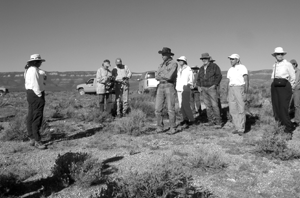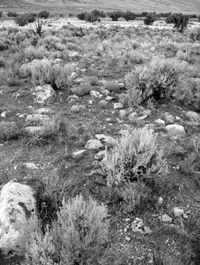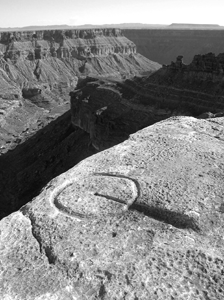Ancient Pueblo Homesteads - Passport in Time
Main menu:
Previous Projects > States A-F
Exploring Ancient Pueblo Homesteads
Kaibab National Forest, Arizona, 2004
by Scott Clemans, FS Public Affairs Officer
“PASSPORT IN TIME” TRANSPORTS VOLUNTEER ARCHAEOLOGISTS BACK TO ANCIENT PUEBLO VILLAGES
HOUSE ROCK VALLEY, Arizona. – Connie Reid stands with me atop a low ridge, the ruins of an ancient rock house scattered around us. The landscape here is high desert. Pinyon pine and juniper struggle to grow in the dry rocky soil. The Grand Canyon zig-zags across the flat landscape to the southeast, while the squat gray-green bulk of the Kaibab Plateau and the towering red Vermillion Cliffs frame the area to the west and north. The charred remains of cliffrose shrubs—victims of a 2001 wildland fire—poke out of the dirt here and there. Aside from scrub pine and maybe some weeds, it doesn’t look like a place you’d want to try to grow anything.
 (Photo: North Kaibab District Archaeologist Connie Reid briefs PIT volunteers on the day’s work plan during the Exploring Ancient Pueblo Homesteads PIT project, Kaibab NF, Arizona, 2004)
(Photo: North Kaibab District Archaeologist Connie Reid briefs PIT volunteers on the day’s work plan during the Exploring Ancient Pueblo Homesteads PIT project, Kaibab NF, Arizona, 2004)But Reid, an archaeologist with the FS’s North Kaibab Ranger District, begs to differ. She points out another ruined home site atop yet another ridge about a half mile away, then gestures from southeast to northwest and tells me, “A thousand years ago, this whole area—from the Grand Canyon all the way around the Kaibab Plateau to Kanab (Utah)—was farmed.”
During the first week of October, the North Kaibab Ranger District hosted a FS PIT project here, a remote area along the north rim of the Grand Canyon that was once home to the ancient Pueblo people. A diverse group of 15 volunteers joined Kaibab NF archaeologists in locating, documenting, and mapping Puebloan farmsteads, trying to better understand the agricultural and trade patterns of the people who once occupied this now-isolated landscape.
Here in House Rock Valley, Reid and I wander through the survey area, noting the remains of homes and field shelters where Puebloan farmers lived, worked, and stored food and tools, and the terrace systems and check dams they built in drainage areas to capture runoff from the Kaibab Plateau. “A few years ago when we completed a survey of this area for another project, we knew that there were terraces and check dams out here,” Reid says. “The purpose of this project is to find out: What’s their extent? How are they laid out? Where did the people live in relation to their farms?”
Reid leads me to a team of volunteers, led by FS archaeologist Melissa Schroeder, mapping the site of yet another pueblo home. Bob Dye and Donna Koster, river guides from Kanab, Utah, measure the dimensions of the rubble and plot the location of artifacts in relation to the home. Gene Cordero, a scenic-flight charter pilot from Kanab, draws sketches of different arrowheads he found among the ruins. “Don’t ask me what I’m doing,” Cordero replies cheerfully to my questioning. “I’m just doing it.”
Learning by doing is an important aspect of the PIT program. The volunteers learn from the professional archaeologists with whom they work, and from each other. And the archaeologists take away a few things from the volunteers, too. “It’s great to soak up the enthusiasm of the volunteers,” Reid says. “Their sense of wonder and discovery reminds me why I do this job.”
 (Photo: The ruins of an ancient Puebloan rock house stand atop a low ridge in House Rock Valley, Exploring Ancient Pueblo Homesteads, Kaibab NF, Arizona, 2004.)
(Photo: The ruins of an ancient Puebloan rock house stand atop a low ridge in House Rock Valley, Exploring Ancient Pueblo Homesteads, Kaibab NF, Arizona, 2004.)It’s also easy to see how this year’s group of volunteers can learn so much from each other. In addition to river guides and a charter pilot, the group includes a pair of retired Stanford University anthropology professors, a career Foreign Service diplomat, and a retired Boeing aeronautical engineer. “We had over 100 applicants for this year’s project,” Reid notes. “Each year, we try very hard to select people from a variety of places and backgrounds—we give preference to those applications where the person writes something about himself and why he wants to participate. It makes for a great working group, and some very interesting conversations around the campfire at base camp each evening, too.”
And, of course, the FS participants spend at least as much time educating their charges as they do actually supervising their work. “Connie and Neil (Weintraub, FS archaeologist) were great—I learned so much from watching and listening to them in the field,” says Joan Radonich, a community college instructor and guidance counselor in Gresham, Oregon. “This is my third PIT project, and I’ve enjoyed each of them more than the last.”
In addition to the archaeology lessons, the volunteers also learned about the people who have lived on this land over the ages. Although the focus of this particular project was the Puebloan people who farmed this arid countryside about 1,000 years ago, Reid notes, “The evidence shows that this landscape was used by people as far back as 8,000 or 9,000 years ago. In fact, it was probably more used in the prehistoric than the historic period.”
 (Photo: a petroglyph carved into a rock on the North Rim of the Grand Canyon indicates a source of water nearby, for those hardy enough to descend into the canyon to reach it.)
(Photo: a petroglyph carved into a rock on the North Rim of the Grand Canyon indicates a source of water nearby, for those hardy enough to descend into the canyon to reach it.)And when the Pueblo people disappeared from the region—either from drought or assimilation—around the 12th century, the land became home to the Paiute Indians. Angie Bulletts, a Kaibab Paiute Indian and FS employee, brought her family out to base camp the first evening to tell the volunteers about the “old ones” which the Kaibab Paiute claim as ancestors, and the importance the land still holds for her people.
Evidence of all of these peoples remains in the House Rock Valley. Every yard or two, it seems, of our walk through the project area, Reid stops to examine yet another artifact—pottery sherds, arrowheads, tool handles, wall fragments—that lies along our path. The ground here is literally littered with history. Paiute side-notched arrowheads are mixed in with red- and black-painted Pueblo pottery sherds and fragments of prehistoric tools.
At another site, a team led by FS archaeologist Russ Snyder and volunteer John Azar of Fredonia, Arizona, found a turquoise bead which, like the obsidian used for arrowheads, were imported to the area through long-distance trade networks that extended as far as Oregon and the Pacific Ocean. This shifting pattern of people and use over time intrigues archaeologists like Reid. “Artifacts are fun, but the more we get into discovering patterns and changes over time—that’s when things get interesting,” she says.
To discover these patterns, the volunteers spent the entire first day of the five-day project simply walking around the area, noting sites worth revisiting later. It’s easy to get wrapped up in the first thing you find, and not notice something even more interesting or important just a few hundred feet away,” Reid says. “Walking the area first gives you a bigger picture and allows you to see how the different sites are interconnected.” After walking the area and determining which sites would receive further attention, the teams returned on the following four days to do the donkey-work of archaeology—inspecting, marking, mapping, sketching.
Reid and her fellow FS archaeologists will ultimately publish the results of this PIT project. The information collected will undoubtedly prove useful to North Kaibab Ranger District managers as they develop forestry, wildlife, range, and recreation programs for the area, helping them to protect the rich cultural resources of the House Rock Valley. But to Reid, the significance of what the volunteers found goes far beyond the pragmatic. “Programs like these really help us expand our knowledge of human history,” she says.
For five days’ work from 15 volunteers without an archaeology degree between them, that’s a pretty impressive contribution.